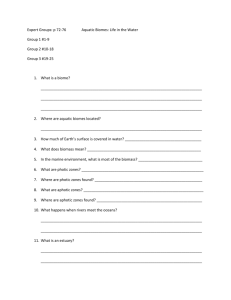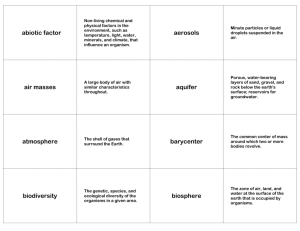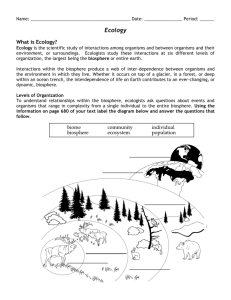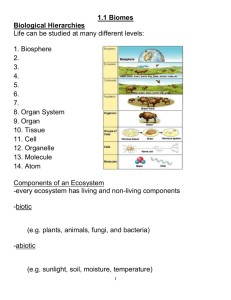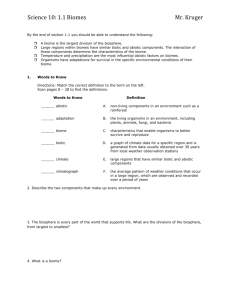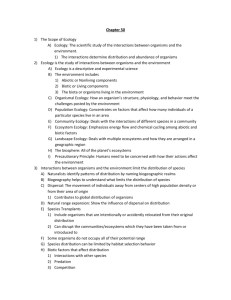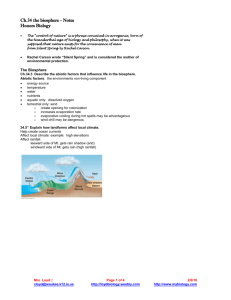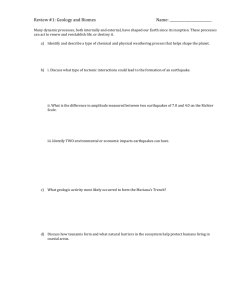Ch. 52- Introduction to Ecology
advertisement
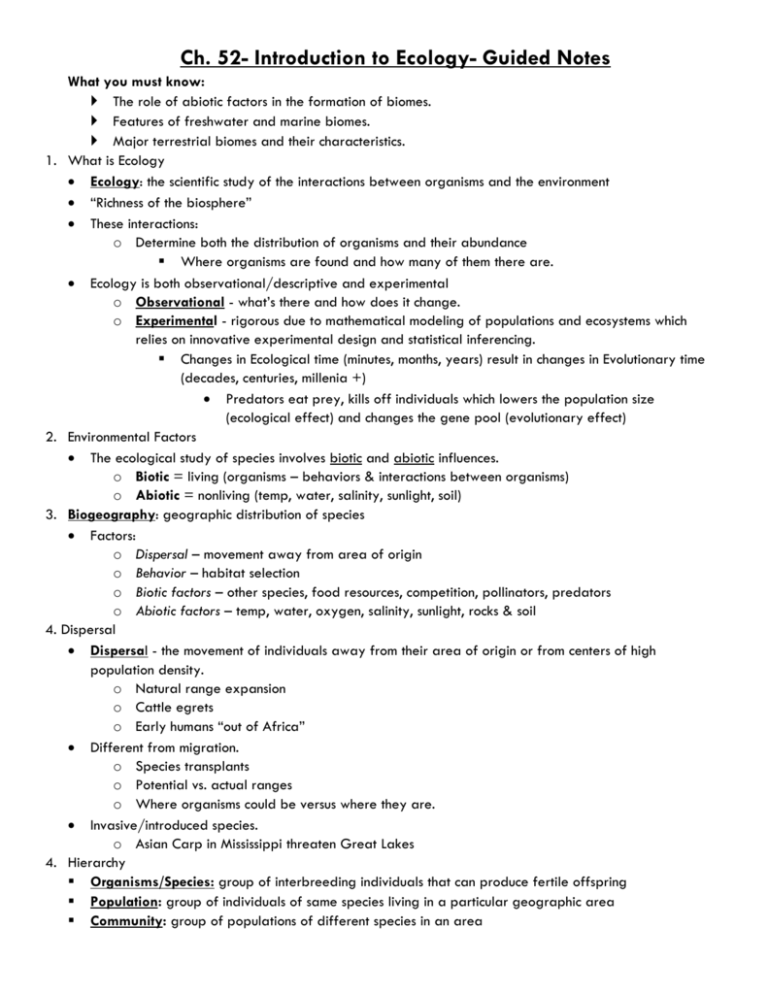
Ch. 52- Introduction to Ecology- Guided Notes What you must know: The role of abiotic factors in the formation of biomes. Features of freshwater and marine biomes. Major terrestrial biomes and their characteristics. 1. What is Ecology Ecology: the scientific study of the interactions between organisms and the environment “Richness of the biosphere” These interactions: o Determine both the distribution of organisms and their abundance Where organisms are found and how many of them there are. Ecology is both observational/descriptive and experimental o Observational - what’s there and how does it change. o Experimental - rigorous due to mathematical modeling of populations and ecosystems which relies on innovative experimental design and statistical inferencing. Changes in Ecological time (minutes, months, years) result in changes in Evolutionary time (decades, centuries, millenia +) Predators eat prey, kills off individuals which lowers the population size (ecological effect) and changes the gene pool (evolutionary effect) 2. Environmental Factors The ecological study of species involves biotic and abiotic influences. o Biotic = living (organisms – behaviors & interactions between organisms) o Abiotic = nonliving (temp, water, salinity, sunlight, soil) 3. Biogeography: geographic distribution of species Factors: o Dispersal – movement away from area of origin o Behavior – habitat selection o Biotic factors – other species, food resources, competition, pollinators, predators o Abiotic factors – temp, water, oxygen, salinity, sunlight, rocks & soil 4. Dispersal Dispersal - the movement of individuals away from their area of origin or from centers of high population density. o Natural range expansion o Cattle egrets o Early humans “out of Africa” Different from migration. o Species transplants o Potential vs. actual ranges o Where organisms could be versus where they are. Invasive/introduced species. o Asian Carp in Mississippi threaten Great Lakes 4. Hierarchy Organisms/Species: group of interbreeding individuals that can produce fertile offspring Population: group of individuals of same species living in a particular geographic area Community: group of populations of different species in an area Ecosystem: community of organisms + physical factors Landscape: mosaic of connected ecosystems Biosphere: global ecosystem 5. Climate Climate: long-term prevailing weather conditions in a particular area o Climate = temperature + precipitation + sunlight + wind Macroclimate vs. microclimate: o Macro: work at seasonal, regional or local level o Micro: small-scale environmental variation (eg. under a log) Climate change: some species may not survive shifting ranges 6. Global Climate Patterns: Latitudinal Variations in Sunlight intensity o Earth’s curved shape causes latitudinal variation in the intensity of sunlight o Because sunlight strikes the equator perpendicularly, the most heat and light per unit of surface area are delivered there o At higher latitudes, sunlight strikes Earth at an oblique angle, and thus the light energy is more diffuse on Earth’s surface Air Circulation & Precipitation Patterns Seasonal Variation in Sunlight Intensity Ocean Currents Mountains affect rainfall 7. Biomes Biomes: major types of ecosystems that occupy very broad geographic regions o Climate and elevation determine biomes a. Tropical Forest distribution: equatorial precipitation: very wet temperature: always warm characteristics: many plants & animals, thin soil b. Desert distribution: 30°N & S latitude band precipitation: less than 30 cm per year temperature: variable daily & seasonally, hot & cold characteristics: sparse vegetation & animals, cacti, succulents, drought tolerant, reptiles, insects, rodents, birds c. Savanna distribution: equatorial precipitation: seasonal, dry season/wet season temperature: always warm characteristics: fire-adapted, drought tolerant plants, herbivores, fertile soil, between a desert and rainforest d. Chaparral Distribution: little bit of most of the continents , coastal Precipitation: seasonal, drought common Temperature: very hot and dry Characteristic: Most of the plants have small, hard leaves which hold moisture. Some of these plants are poison oak, scrub oak, Yucca Wiple and other shrubs, trees and cacti. The animals are all mainly grassland and desert types adapted to hot, dry weather. coyotes, jack rabbits, mule deer, alligator lizards, horned toads, praying mantis, honey bee and ladybugs. e. Temperate Grassland distribution: mid-latitudes, mid-continents precipitation: seasonal, dry season/wet season temperature: cold winters/hot summers characteristics: prairie grasses, fire-adapted, drought tolerant plants; many herbivores; deep, fertile soil f. Northern Coniferous Forest/ Taiga distribution: high-latitude, northern hemisphere precipitation: adequate to dry (temperate rain forest on coast) temperature: cool year round characteristics: conifers; diverse mammals, birds, insects, etc. g. Temperate Broadleaf Forest distribution: mid-latitude, northern hemisphere precipitation: adequate, summer rains, winter snow temperature: moderate warm summer/cool winter characteristics: many mammals, insects, birds, etc.; deciduous trees; fertile soils h. Artic Tundra distribution: arctic, high-latitude, northern hemisphere precipitation: dry temperature: cold year round characteristics: permafrost, lichens & mosses, migrating animals & resident herbivores i. Alpine Tundra distribution: high elevation at all latitudes precipitation: dry temperature: cold year round characteristics: permafrost, lichens, mosses, grasses; migrating animals & resident herbivores 8. Climograph Climograph: plot of temperature & precipitation in a particular region 9. Marine/Aquatic Biomes Account for the largest part of the biosphere in terms of area Can contain fresh (aquatic; less than 1% saline), brackish, or salt (marine; ≈ 3% saline) water Oceans o Cover about 75% of Earth’s surface o Have an enormous impact on the biosphere o Evaporation provides majority of Earth’s rainfall o Ocean temperatures affect climate and wind patterns o Algae and photosynthetic bacteria provide oxygen and consume CO2 10. Zonation Are stratified into zones or layers defined light penetration, temperature, and depth Thermoclines - Narrow vertical zone of abrupt temperature change. o Photic Zone – sufficient light for photosynthesis o Aphotic Zone – little light penetration o Benthic Zone – bottom substrate composed of sand, organic, and inorganic materials (ooze) o Benthos – Organisms that live in the benthic zone o Detritus – dead organic matter that rains down from the productive photic zone. In aquatic communities organisms are distributed according to: o water depth o light penetration o distance from the shore o open water versus benthic zone 11. Nutrient Turnover Lakes and other marine/aquatic biomes experience turnover. a. Lakes Oligotrophic - nutrient poor, oxygen rich Eutrophic - nutrient rich, oxygen poor Periodic oxygen depletion; large amount of decomposition Biota - fish, invertebrates depending on O2 levels, phyto- and zooplankton. b. Wetlands Inundated with water at least periodically Plants adapted to water-saturated soil Highly productive Important filters and breeding grounds Birds, carnivores, crustaceans, plants, reptiles. c. Streams & Rivers Current with lots of aeration Aquatic plants and phytoplankton, fish, invertebrates, etc. o Ex. Potomac and Anacostia rivers, Rock and Sligo creeks, Chesapeake Bay watershed. d. Estuaries Transition between rivers and sea - brackish water with flow between the two. Variable salinity depending on temperature, depth, and tides. Worms, oysters, crabs, fish, etc. Highly productive and important in filtering water. e. Intertidal Zones Periodically submerged and exposed. Physical environment varies vertically, so species range varies vertically. Oxygen and nutrients renewed tidally. Sea grass, algae, worms, crustaceans, crabs, etc. f. Oceanic Pelagic Zone (Open Water) Open ocean, particularly deep water. Driven by currents - lots of light and oxygen. Large photic zone. Experience nutrient turn over - depends on temperature. 70 percent of world’s surface Phytoplankton and photosynthetic bacteria - makes our oxygen! Zooplankton, fish, cephalopods, marine mammals, etc. g. Coral Reefs Formed from coral “skeletons” Photic zone - zooxanthellae need light for photosynthesis; sensitive to change in temperature Fringing reef --> barrier reef --> atoll island Unicellular algae, coral animals, fish and invertebrate diversity. h. Marine Benthic Zone Below neritic (near, coastal) and pelagic (noncoastal, open water) zones. Deep benthic = abyssal zone; deep sea vents with chemoautotrophs. Shallow benthic - oxygen from algae and seaweed. Chemo- or photoautotrophs; worms, arthopods, echinoderms, etc. Warm Up Questions 1. Dead organic matter that rains down from the productive photic zone.___________________ 2. The movement of individuals away from their area of origin or from centers of high population density___________________________ 3. Nutrient rich, oxygen poor lake.________________ 4. Long term weather patterns on a global, regional and local level. ____________________________ 5. What are the 4 factors that affect aquatic communities distribution of organisms 6. Name examples of biotic and abiotic factors in the environment surrounding PPHS. 7. Which biomes can be found in Colorado? 8. Define the following terms: a. population b. community c. ecosystem d. biosphere
